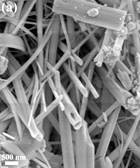主要研究主題及成果說明 |
|||
1.微奈米無機材料 |
|||
| 1.1 中孔洞的二氧化矽材料 | |||
  |
|||
| Fig. 1.1 Schematic illustrating the fabrication of ordered mesoporous MCM-41 and MCM-48. 29Si NMR spectra of Si-MCM-41 (a), rehydrated Si-MCM-41 (b) and (NC3)Si-MCM-41(c). 1: -Si(C3N)(OR)2; 2: =Si(C3N)(OR); 3:≡Si(C3N); Q4: (Si(SiO)4); Q3: (Si(SiO)3OH); Q2: (Si(SiO)2(OH)2) | |||
| 1.2 具奈米結晶結構的TiO2表面型態的控制 | |||
 |
|||
| Fig. 1.2 Formation of nanocrystalline TiO2 rods and hallow-tubes is favorable at lower temperatures when the pH value is below IEP of TiO2 (path I); while higher temperatures encourage the formation of a tabular structure of TiO2 (path Ⅱ). | |||
    |
|||
Fig. 1.3 FE-SEM images of nanocrystalline TiO2 rods, hollow-tubes, and platelets prepared at different hydrothermal temperatures; (a) SDS-90, (b) SDS-120, (c) SDS-150, and (d) SDS-180. |
|||
| 1.3合成高比面積的有序中孔洞二氧化鈦(銳鈦礦)及其光觸媒的應用 | |||
 |
|||
| Fig. 1.4 Ordered mesoporous TiO2 materials with an anatase framework and a hexagonal mesostructure showing efficient photocatalytic efficiency have been successfully synthesized via a cationic surfactant-assisted sol-gel synthesis under hydrothermal condition. | |||
| [1][2][3][4][5][6] | |||